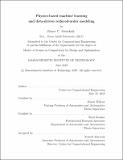| dc.contributor.advisor | Karen Willcox and Boris Kramer. | en_US |
| dc.contributor.author | Swischuk, Renee C.(Renee Copland) | en_US |
| dc.contributor.other | Massachusetts Institute of Technology. Computation for Design and Optimization Program. | en_US |
| dc.date.accessioned | 2019-11-04T19:53:02Z | |
| dc.date.available | 2019-11-04T19:53:02Z | |
| dc.date.copyright | 2019 | en_US |
| dc.date.issued | 2019 | en_US |
| dc.identifier.uri | https://hdl.handle.net/1721.1/122682 | |
| dc.description | This electronic version was submitted by the student author. The certified thesis is available in the Institute Archives and Special Collections. | en_US |
| dc.description | Thesis: S.M., Massachusetts Institute of Technology, Computation for Design and Optimization Program, 2019 | en_US |
| dc.description | Cataloged from student-submitted PDF version of thesis. | en_US |
| dc.description | Includes bibliographical references (pages 123-128). | en_US |
| dc.description.abstract | This thesis considers the task of learning efficient low-dimensional models for dynamical systems. To be effective in an engineering setting, these models must be predictive -- that is, they must yield reliable predictions for conditions outside the data used to train them. These models must also be able to make predictions that enforce physical constraints. Achieving these tasks is particularly challenging for the case of systems governed by partial differential equations, where generating data (either from high-fidelity simulations or from physical experiments) is expensive. We address this challenge by developing learning approaches that embed physical constraints. We propose two physics-based approaches for generating low-dimensional predictive models. The first leverages the proper orthogonal decomposition (POD) to represent high-dimensional simulation data with a low-dimensional physics-based parameterization in combination with machine learning methods to construct a map from model inputs to POD coefficients. A comparison of four machine learning methods is provided through an application of predicting flow around an airfoil. This framework also provides a way to enforce a number of linear constraints by modifying the data with a particular solution. The results help to highlight the importance of including physics knowledge when learning from small amounts of data. We also apply a data-driven approach to learning the operators of low-dimensional models. This method provides an avenue for constructing low-dimensional models of systems where the operators of discretized governing equations are unknown or too complex, while also having the ability to enforce physical constraints. The methodology is applied to a two-dimensional combustion problem, where discretized model operators are unavailable. The results show that the method is able to accurately make predictions and enforce important physical constraints. | en_US |
| dc.description.statementofresponsibility | by Renee C. Swischuk. | en_US |
| dc.format.extent | 128 pages | en_US |
| dc.language.iso | eng | en_US |
| dc.publisher | Massachusetts Institute of Technology | en_US |
| dc.rights | MIT theses are protected by copyright. They may be viewed, downloaded, or printed from this source but further reproduction or distribution in any format is prohibited without written permission. | en_US |
| dc.rights.uri | http://dspace.mit.edu/handle/1721.1/7582 | en_US |
| dc.subject | Computation for Design and Optimization Program. | en_US |
| dc.title | Physics-based machine learning and data-driven reduced-order modeling | en_US |
| dc.type | Thesis | en_US |
| dc.description.degree | S.M. | en_US |
| dc.contributor.department | Massachusetts Institute of Technology. Computation for Design and Optimization Program | en_US |
| dc.identifier.oclc | 1123218324 | en_US |
| dc.description.collection | S.M. Massachusetts Institute of Technology, Computation for Design and Optimization Program | en_US |
| dspace.imported | 2019-11-04T19:53:00Z | en_US |
| mit.thesis.degree | Master | en_US |
| mit.thesis.department | CDO | en_US |
